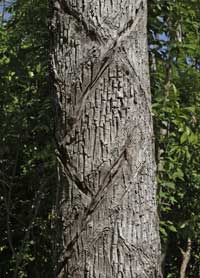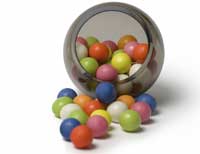Materials science to the rescue: easily removable chewing gum Understand article
Halina Stanley investigates the history of chewing gum, how the chemistry of the gum affects its properties, and how scientists are using this knowledge to make chewing gum less of a pollutant.

Love it or hate it, chewing gum is a ubiquitous and usually benign activity. Benign, that is, until some idiot decides to put some in your hair. Wouldn’t it be nice if gum didn’t stick to carpets, shoes and the underside of school desks? Terry Cosgrove, professor of chemistry at Bristol University, UK, has decided to take action; his easily removable chewing gum may save millions in cleaning billsw1.
The stickiness of chewing gum may be an unwanted side-effectw2, but chewiness is a very desirable property. Manufacturers of chewing gum – and old wives’ tales – suggest that chewing gum can be helpful for improving focus, concentration and alertness, reducing stress, and enhancing weight loss; we now even have versions that help us stop smoking and prevent seasickness. There are even marketing claims that chewing gum can significantly reduce tooth decay and bad breath. However, a ‘scientific’ survey of two high-school students, carried out by the author, suggests that children actually chew gum as a displacement activity for pen and pencil chewing: chewing appears to be a universal human need.
So what is chewing gum? Historically it was simply resin bled from trees. For example, in the Yucatan Peninsula in Central America, Amerindians (native Americans) extracted gum from a tropical evergreen tree called the Manilkara chicle. More than a thousand years ago, they made gashes in the trunk, collected the drips of gum and then heated it until it reached a useful consistency for chewing. The word ‘chicle’ simply means ‘sticky stuff’ in the ancient Nahuatl Aztec language.

to collect the sap
Image courtesy of Luis Fernández García;
image source: Wikimedia Commons
But chewing gum is not – even originally – a purely American habit: European Stone-Age people also used to chew gum. In 2007, Sarah Pickin from the University of Derby, UK, found a 5000-year-old piece of gum, complete with fossilised tooth marks, while on an archaeological dig in Finlandw3. This gum was extracted from birch trees by Stone-Age people and heated to form a kind of tar which would have been solid when cold, but softer if warmed. It seems that it was used as glue for repairing cooking pots or for sticking arrowheads onto their shafts, but clearly it was also chewed. Professor Trevor Brown, Sarah’s tutor at the University of Derby, says that this gum contains natural antiseptic compounds, so Neolithic people would have had their own medicated chewing gum to treat mouth infections.
Chicle, and other tree saps – including latex, from which natural rubber can be produced – are natural polymers. These polymers – polyterpenes – are composed of thousands of C5H8 isoprene subunitsw4. Depending on the species of tree or plant, the natural polymers may be more or less highly branched, have differing sizes (molecular weight) and may be mixed with volatile essential oils, all of which lead to differing softnesses and elasticities. (The effects of the chemical structure on the physical properties of polymers can be readily investigated in the classroomw5.) These viscous liquids can be solidified by introducing cross-links into the polymers; this process can be investigated by adding sodium tetraborate solution to polyvinylalcohol ‘white’ glue. Worksheets for this classic experiment can be found on a number of websitesw6 and it is interesting to observe the effect of varying cross-link density (by changing the ratio of sodium tetraborate to glue).

Public domain image;
image source: Wikimedia Commons
Although the first chewing-gum factory, which opened in the USA in 1870, used sap from the Manilkara chicle tree as its gum base, modern chewing gums use synthetic polymers. With consumption of gum at a staggering 50 billion sticks a year in the USA alone (around 170 sticks per capita per year), relying solely on tropical forests to supply the raw material is not a viable option. Some formulations may still include natural ingredients but data are hard to come by – these are closely guarded commercial secrets. Instead, the synthetic polymer gum bases used in commercial chewing gum mimic and optimise the properties of the natural polymers: they are inert, insoluble and entirely non-nutritive. These polymers are synthesised from petroleum products to which sugar (or a sweetener such as aspartame) and other flavourings are added. Colouring (traditionally bright pink for bubblegum) is the only additional ingredient, unless the gum is to be used in a medical application, for example to help quit smoking, since these gums obviously also contain a drug (e.g. nicotine) in a water-soluble form.
The formulation of gum base, so that it gives the right chewiness (elasticity) and flavour release, is complex and varies depending on the desired elastic properties (bubblegum is more elastic than ordinary chewing gum, for example). It contains various elastomers (to provide the elasticity), resins (that act as binders), fillers (that contribute to overall texture and may help create low-calorie gums by bulking the gum up without adding nutritive ingredients) and plasticisers (to soften the mixture)w7.
The main component is typically a mixture of synthetic elastomers such as polyisobutylene, isobutylene-isoprene co-polymers (butyl rubber), styrene-butadiene co-polymers and polyvinylacetate – you may have heard of some of these in connection with car tyres. These polymers are all insoluble in water, hydrophobic (water-hating) and non-biodegradable. This explains why scrubbing your carpet with water doesn’t shift chewing gum. Soaking in water won’t help either. And if the gum is stuck to a concrete wall or paving stone, rain won’t wash it away.
When a stick of gum is chewed, the water-soluble part (sugar and flavourings) is gradually released, while the polymer base (the plastic) remains. After a while, the gum becomes tasteless because all the flavourings have been released; the gum base never dissolves away. The warmth of the mouth softens the gum base and makes it more pliable, but it isn’t really changed and will harden again on cooling (although it may become somewhat tougher if any plasticisers are released). To blow the best bubbles, chew until all the sugar has been released and only the stretchy polymer base is left: sugar is not a polymer, doesn’t stretch, and can cause bubbles to collapse prematurely.
So to return to the original question: why does chewing gum stick so well to most surfaces? The science of adhesion is complicated (see box) and in the case of chewing gum, probably involves both mechanical effects and chemical bonds. However, whatever the sticking mechanism, the two surfaces must be in very close contact, to ‘wet’ each other (‘wetting’ describes the contact between a liquid and a solid surface, resulting from intermolecular interactions) before they will adhere. Soft chewing gum fits the bill perfectly. And once it is stuck, the energy that you put into pulling it doesn’t go into breaking the bonds holding the gum to the surface (as you would like); instead, you just stretch and slide the polymer molecules in the gum. This is a general property of polymers (above a certain temperature): the long tangled molecules tend to have lots of bends that can be straightened a little by pulling on them. (You can demonstrate the stretching of polymers in the classroom using polythene bagsw8). So how does this knowledge help us make chewing gum that is less sticky?
Adhesion
There are many ways in which things stick. These include:
- Mechanical interlocking, such as occurs with Velcro or glues that flow into cracks and crevices of the substrate and then harden, physically locking on to the substrate.
- Intermolecular attractions (e.g. hydrogen bonds and Van der Waals forces). Geckos are renowned for scampering up smooth vertical walls (even glass). Each of their feet is covered in nearly 500 000 hairs, which adhere to surfaces via weak Van der Waals forces (Autumn et al, 2000). The adhesion of a gecko’s foot to the wall needs to be reversible (imagine the poor gecko if it were not), so this is a good strategy: the forces are weak but the cumulative effect of 500 000 hairs is not; by peeling its foot off the surface, the gecko can break the forces bit by bit.
- The formation of chemical bonds (covalent or ionic bond formation). Mussels, which unlike geckos are not very mobile creatures, stick firmly to rocks in stormy weather using rather stronger covalent bonds. And some glues form covalent or ionic bonds with surfaces, although the exact details tend to be commercial secrets.
- Interdiffusion at the interface. This generally leads to very strong adhesion, since the two materials are mixed at a molecular level. Many materials interdiffuse to some extent – two similar polymers at a moderate temperature will interdiffuse, and the process is important in metal-metal contacts and metal-metal oxides.
- Electrostatic attractions. Researchers at the US National Institute of Standards and Technology (NIST) are currently examining the possibility of using electrostatic charges to bond semiconductors.
Reducing the stretchiness of chewing gum is not a sensible strategy: who would want to chew a bouncy ball? Instead, Professor Cosgrove has incorporated a hydrophilic (water-loving) polymer into the gum base. When the gum is chewed, the hydrophilic polymer absorbs saliva and softens the gum. It also migrates to the surface. This means that there is always a thin film of water on the surface of the wad of chewing gum after chewing. This persistent film of water ends up between the gum and any surface, preventing close contact and preventing the gum sticking. Simple? Not really. If a hydrophilic polymer were simply added, it wouldn’t mix with the gum base (just as you can’t mix oil and water). Instead, a co-polymer (a polymer made of two types of monomers, or building blocks) that has both hydrophilic and hydrophobic parts must be used; even this needs to be carefully added to avoid phase separationw9. Paint manufacturers use a similar trick: they mix the elastomeric polymer(s), which will dry to become a water-resistant coating, with water using this kind of co-polymerw10.

The addition of the water-loving polymer has another benefit. Ordinary chewing gum is pretty resistant in the environment: it doesn’t dissolve in rain and weathering tends to harden it, which makes it a very persistent pollutant (think of those grey blobs on the pavement!). In contrast, the gum containing a hydrophilic polymer (the non-stick variety of chewing gum) slowly disintegrates in the presence of water.
Although the co-polymer used in non-stick chewing gum has been patentedw11, the team is still perfecting the exact composition of its gum base. So far they have tested more than 200 different formulations – I understand Violet Beauregarde was one of their first employees (read Charlie and the Chocolate Factory by Roald Dahl). In addition to the usual polymer parameters of molecular weight, degree of branching and cross-link density, the team has to optimise their water-loving/-hating schizophrenic co-polymer. Too much water-loving polymer and the gum may be too soft. The wrong composition and the gum may fall apart in the mouth or still stick to surfaces. The team seems confident that a product will be ready for marketing in the near future. I’m keeping my fingers crossed that it proves popular – otherwise we’ll just have to put non-stick coatings on the underside of all the school desks!
Acknowledgements
I would like to thank Professor Cosgrove for useful discussions and for critically reading this manuscript.
References
- Autumn K et al (2000) Adhesive force of a single gecko foot-hair. Nature 405: 681-685. doi: 10.1038/35015073. Download the article free of charge here or subscribe to Nature today: www.nature.com/subscribe
- In Roald Dahl’s well-loved children’s book, Charlie and the Chocolate Factory, Violet Beauregarde is a loathsome child addicted to chewing gum
- Dahl, R (2007 and earlier) Charlie and the Chocolate Factory. Puffin Books, London, UK. ISBN 978-0141322711
Web References
- w1 – More information about Professor Cosgrove’s research is available on the University of Bristol website: www.chm.bris.ac.uk/pt/polymer/introduction.shtml
- w2 – An entertaining video of Professor Cosgrove attempting to remove chewing gum from shoes (‘Shoe testing’) can be found at www.revolymer.com
- w3 – The story of Sarah’s discovery can be read here: www.derby.ac.uk/press-office/news-archive/heres-a-story-to-get-your-teeth-into
- w4 – To learn about rubber- and chicle-producing plants and their polymers, see:
- http://waynesword.palomar.edu/ecoph13.htm
- http://en.wikipedia.org/wiki/Chicle
- http://en.wikipedia.org/wiki/Terpene
- w5 – A great teaching activity about changing the properties of polymers and plastics (activity number 3.1.5) can be downloaded from the Royal Society of Chemistry (UK) website: www.chemsoc.org/networks/learnnet/inspirational
- w6 – Informative websites on the polyvinylalcohol and sodium tetraborate (borax) experiment include:
- www.chemsoc.org/networks/learnnet/inspirational (specifically experiment 3.1.8, ‘Investigating cross-linking, making slime’)
- www.iop.org/activity/education/Events/
- Events%20for%20Teachers/Schools%20Physics%20Group/file_5747.doc
- http://pslc.ws/macrog/activity/ball/lev3/level3p.htm
- w7 – Learn more about the basis of chewing gum on the Gumbase website: www.gumbase.com
- w8 – An interesting teaching activity (experiment 3.1.6, ‘Polythene bags’) for understanding the stretching of polymers can be found on the Royal Society of Chemistry website: www.chemsoc.org/networks/learnnet/inspirational
- w9 – A video about how gum bases are made (‘Making clean gum’) can be viewed here: www.revolymer.com
- w10 – Co-polymers of polyvinylacetate (a water-insoluble polymer) with polyvinylalcohol (a water-loving polymer) as used in paint are very well described here: http://pslc.ws/macrog/pva.htm
- w11 – The patent (WO/2006/016179, ‘Polymeric materials having reduced tack, methods of making the materials and chewing gum compositions containing such materials’) can be viewed on the World Intellectual Property Organization website: www.wipo.int/pctdb/en/wo.jsp?wo=2006016179&IA=WO2006016179&DISPLAY=STATUS
Resources
- For a classroom activity to measure the citric acid concentration in chewing gum, see:Gadd K, Szalay L (2008). Chewing flavours. Science in School 8: 34-37.
- If you want to follow the reviewer’s suggestion for a chewing-gum testing activity, why not have a look at the chocolate-tasting activity from Science in School?
- Schollar J (2006). The chocolate challenge. Science in School 2: 29-33.
- For some exciting background reading on the chewing-gum industry, see:Redclift M (2004) Chewing Gum: The Fortunes of Taste. New York, NY, USA: Routledge. ISBN: 9780415944182. and ‘All About Chewing Gum’: www.wrigley.com/wrigley/kids/kids_report.asp
Review
This is a new way for teachers to become popular among students: buy lots of different chewing gums! Let the students be the experts by assessing different brands – perhaps by giving marks for different properties such as chewiness, duration of flavour release, and consistency. Read the article and discuss the chemical expressions that are used. Finally – try to make your own easily removable chewing gum.
Sølve Tegner Stenmark, Norway





